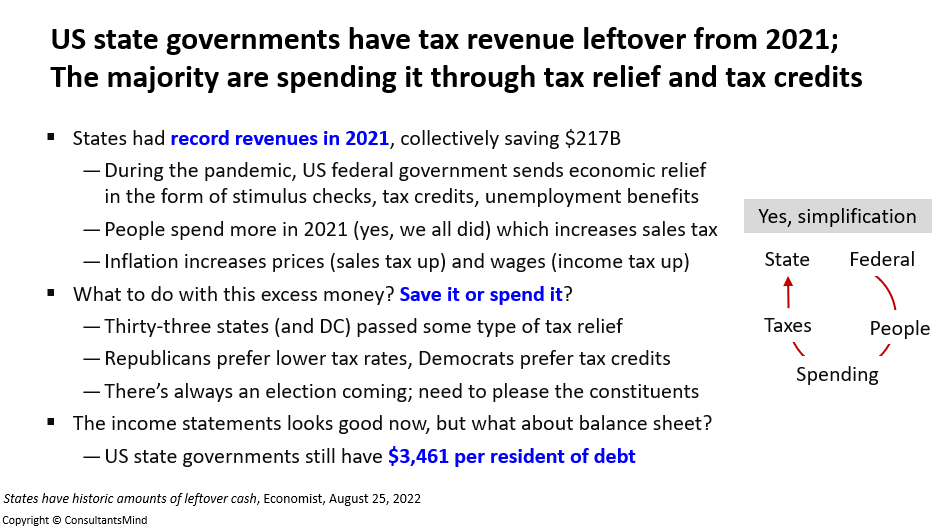
One PowerPoint a day
I tell junior consultants to practice making PowerPoints. Read a simple article, group the ideas into buckets. Write a useful title. Have a diagram that helps understanding. Use data points to persuade. This is one for today.
US state tax revenue was up in 2021
The individual states (and DC) saved $271 billion in 2021. Taxes > spending. Apparently, this is a record amount. Perhaps a bit of a libertarian smirk, but when the government is richer than ever, uh, makes me pause.
Time flies, it’s not 2020 anymore
Yes, this surprised me, because wasn’t economic activity at a standstill because of the pandemic? Didn’t we just have a discussion about the falling tax base and the inability to pay for social services? After all, how do you collect state tax revenue when no one is buying and selling anything.
Then, when I look at the calendar and remind myself that its been more than 26 months since the first Covid-19 case in the US. John, this is not March 2020.
US Federal government spending kicks it off
Not an economist, but many will agree that the US government needed to do something at the onset of the pandemic. Without some action, it would have been a viscous depression. You don’t need to have a Keynesian tattoo on your shoulder to see that. It’s too easy to forget that it was a very scary time.
So, stimulus checks are mailed. Tax credits are given. Unemployment benefits extended.
Did they do too much? I have my own opinions (and you do too), but that’s a separate conversation. Let’s get back to the 50 State and DC having lots of tax revenue left over.
US consumers have more money, spend it
The US consumer had an increase in net savings over the last two years. Americans got money, want to spend it.
Sales taxes up
People spend money. Sales taxes are collected. Prices of goods and services go up. So, even though you’re buying the same amount of bananas, car washes and Netflix, the total $ of the same basket size is higher.
Higher sales amount x same sales tax rate = higher tax revenue.
Income taxes up
Great resignation. Shortage of labor. Higher expectations of work & pay = rising wages.
Higher wages x same (or higher tax bracket) = higher income taxes.
The majority of States are offering tax cuts, tax credits
In the spirit of “helping out voters”, Republican-led states are lowering tax rates for individuals and companies. Democratic-dominated states are sharing tax credits. Different parties, similar fiscal effect.
Yes, 33 states are lowering taxes and giving some of the money back to people. Good, right?
What about the balance sheet?
The awkward reality is that states still owe a lot of money. Yes, their income statement might have been good in 2021, but what about the average $3,200+ of debt per resident that they owe. Doing case interview, back-of-the envelope math, $3,200 x 330 Million Americans = $1 Trillion (with a T) in debt.
$1 Trillion in state debt
Yes, the States (and DC) have about $1 Trillion in debt. Perhaps have have great interest rate coverage, but with interest rates going up (6 fed fund rate increases in 2022 so far), that interest rate burden will increase. A quick Google search shows that the total municipal bond debt (including counties, municipalities and entities smaller than a “State”) total $4 Trillion. In context, the US GDP is $23 Trillion.
Original Economist article here.
Making one-pagers to practice my “executive summary” skills
See below.
